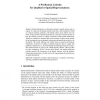COSIT
1999
Springer
14 years 4 months ago
1999
Springer
Spatial information is information bound to spatial entities such as regions. It is based on the spatial structure alone (the valley includes the field) or connects thematic predic...
SIGMOD
1999
ACM
14 years 4 months ago
1999
ACM
Several techniques that compute the join between two spatial datasets have been proposed during the last decade. Among these methods, some consider existing indices for the joined...
SIGMOD
1999
ACM
14 years 4 months ago
1999
ACM
Selectivity estimation of queries is an important and wellstudied problem in relational database systems. In this paper, we examine selectivity estimation in the context of Geogra...
DEXAW
1999
IEEE
14 years 4 months ago
1999
IEEE
Schema versioning provides a mechanism for handling change in the structure of database systems and has been investigated widely, both in the context of static and temporal databa...
DANTE
1999
IEEE
14 years 4 months ago
1999
IEEE
The growing importance of spatial data has made it imperative that spatial operations be executed efficiently. The most expensive operation is the join for spatial databases. This...
WISE
2000
Springer
14 years 4 months ago
2000
Springer
Most Internet search engines are keyword-based. They are not efficient for the queries where geographical location is important, such as finding hotels within an area or close to ...
VLDB
2001
ACM
14 years 4 months ago
2001
ACM
Much of the data that we encounter has a spatial (geographic locational) aspect yet this has not been readily exploited by traditional RDBMS. Over the past five years there has be...
VLDB
2001
ACM
14 years 4 months ago
2001
ACM
The proliferation of mobile and pervasive computing devices has brought energy constraints into the limelight, together with performance considerations. Energy-conscious design is...
SSD
2001
Springer
14 years 4 months ago
2001
Springer
Several studies have focused on the efficient processing of simple spatial query types such as selections and spatial joins. Little work, however, has been done towards the optimiz...
COSIT
2001
Springer
14 years 4 months ago
2001
Springer
One of the central questions of spatial reasoning research is whether the underlying processes are inherently visual or spatial. The article reports a dual-task experiment that was...




